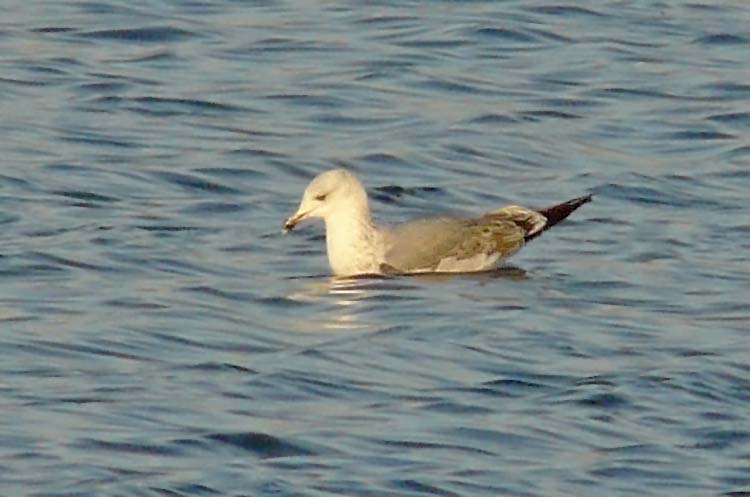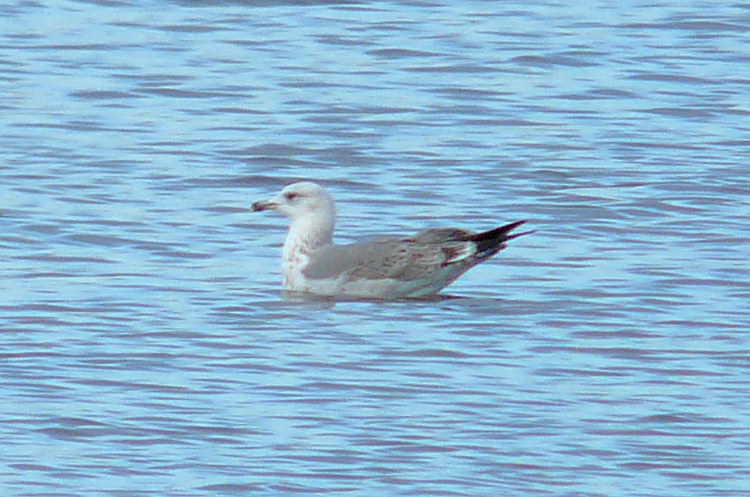Yellow-legged Gull Larus michahellis2nd Winter, December 2011, Warwickshire |

Plate 1

Plate 2

Plate 3

Plate 4
© A. R. Dean
Yellow-legged Gulls and Caspian Gulls in their second winter can be especially challenging, as they lack the range of characters displayed by 1W, such as distinctive mantle ands scapular patterns, while there is some convergence in tertial pattern. Smaller and more delicate examples of YLG (usually females) can also lack the squarer, flat-topped head profile and rather deep, blunt-tipped bill profile of larger birds. The individual in the images above is an example of such a relatively small and delicate 2cy bird and its identity was not immediately obvious. It should perhaps be regarded as of uncertain identity rather than an established Yellow-legged Gull, with gulls of 'mixed' lineage (involving two or more of YLG, CaspG and HG) always among considerations. At times it appeared finely proportioned with a slight and slender bill and relatively small and rounded head, with maxillary feathering extending forward along the base of the bill (plate 1). At other times it appeared more robust, with a more bull-necked configuration and a stockier and blunter-looking bill (plate 2), though even then its bill was slighter than those of most nearby Lesser Black-backs (plate 3). The bill never quite matched the slender, parallel-sided and pointed shape of a 'classic' cachinnanns. Additionally, the dingy and well-marked underwing coverts and the less than cleanly white head also pointed towards michahellis. In email discussions, Peter Adriaens pointed out two little-documented features of the primary pattern which also favoured michahellis :
In the majority of 2W cachinnans, the inner and outer webs of the innermost two or three primaries show a similarly grey hue, so that these feathers have a relatively uniform and pale appearance. In the remaining inner primaries, the inner webs are grey but the outer webs are brownish, producing a 'Venetian-blind' pattern. Thus, there is an obvious contrast between p1-p3 and the remaining inner primaries (see images on Peter's website). 2W cachinnans with a 'Venetian blind' pattern across all the inner primaries are much in the minority. In michahellis there is a more even divide between individuals with rather uniformly grey p1 - p3 and those which show a 'Venetian blind' pattern across all the inner primaries.
In 2W cachinnans the extent of dark on the underside of the outer primaries tends to be slightly more restricted than in michahellis, so that the underside of the 'hand' often has a more 'hollowed out' appearance.
Neither of these features is absolute, and exceptions are encountered not infrequently, but each provides an additional 'percentage' feature in diagnosis. In the individual above, both features again favour michahellis (plate 4).
However, as an illustration of how convergent in general appearance some individuals can be, compare plates 1 - 4 above with at-rest and spread-wing images (from Surfbirds) showing an undoubted cachinnans, photographed by Steve Arlow in Essex in 2006. It shows a small mirror on p10 which, together with other features, confirms that it is a 2W cachinnans. Yet, note its general similarity to the individual in plates 1 - 4 above. It is also one of that minority of 2W cachinnans which displays a 'Venetian blind' pattern on p1 - p3.
|
|
|
|
Home |
Mediterranean
| Laughing |
Franklin's |
Little |
Sabine's |
Bonaparte's |
Black-headed |
Ring-billed | Common |
Lesser Black-backed | |